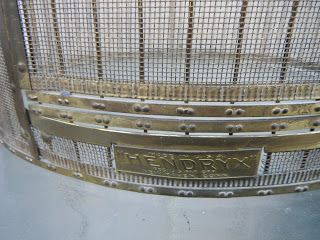This is the second visit to my blog for Miguel. He first contributed in May 2015 and he's done another marvelous job on this first cage. This is how I introduced him in May:
Miguel contacted me through this blog and said he collected Hendryx cages too. He gets them from markets or on the internet. He repairs them, if needed, then intervenes artistically so they will be more pleasing to the senses. He has a creative spirit and does all his work freehand. These belong to a collection that is "an artistic intervention to an ancient object without losing its original function".
Let's get some pictures in here so you can see what I am talking about.
This cage is found in my Hendryx catalogs from the late 1920s to the early-to-mid 1930s. The seed screen guard has been removed for easy viewing of the floor which is decorated with a crane and a cherry tree.
Note the polished base as well as the enhanced upright to the stand. The upright pole is wrapped with actual tree bark.
The perches and swing are hand painted and covered with a polyester layer so the paint is protected and is not harmful to the birds.
Look at this amazing art work!!
This bird is a model and does not live in the cage.
Here are several more pictures of another cage of his.
Here are several more pictures of another cage of his.
For more photos from Miguel, look at my May 2015 blog post.
Thank you for joining me as we celebrate Miguel's artistic abilities added to the always-great Hendryx cages. It's always a pleasure hearing from him.
If you have any pictures of Hendryx cages you found over the summer or have any questions, please write to me at tweetthings53@gmail.com. I will add the pictures as a guest contributor.
Fall is around the corner but the weather should still be good enough for more shopping for and buying of those amazing cages by The Andrew B. Hendryx Co.
Have a blessed day. Happy Hunting.
Barbara


























































